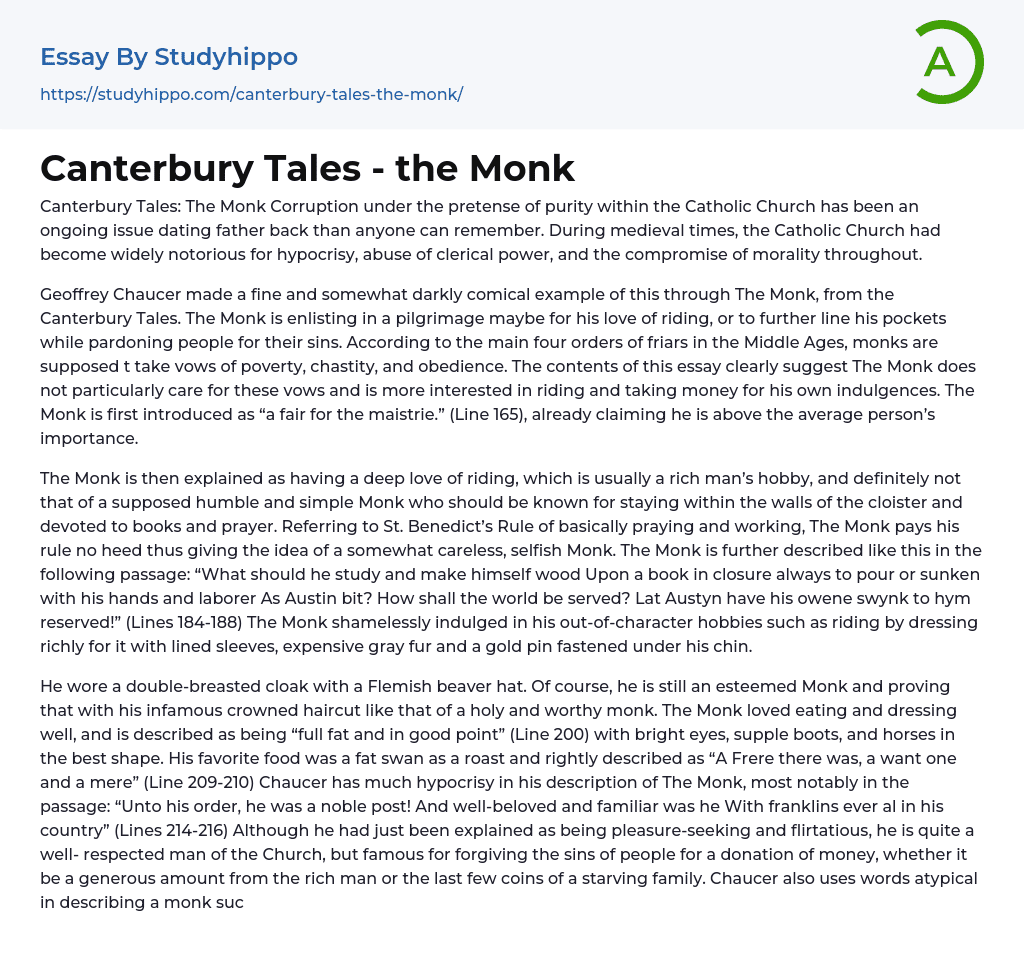Canterbury Tales: The Monk Corruption within the Catholic Church has been an ongoing issue for centuries. In medieval times, the Church was known for hypocrisy, abuse of power, and compromising morality. Geoffrey Chaucer portrayed this through The Monk, a character in the Canterbury Tales. The Monk joins a pilgrimage, possibly motivated by his love for riding or to exploit pardons for financial gain.
According to the four main orders of friars during the Middle Ages, monks were required to take vows of poverty, chastity, and obedience. However, the essay's content strongly indicates that The Monk does not value these vows and is more interested in horse riding and acquiring wealth for his personal pleasures. When The Monk is first introduced, he is described as being "a fair for the maistrie" (Line 165), implying that he conside
...rs himself superior to the average person. Furthermore, it is revealed that The Monk has a great passion for horse riding, which is typically seen as a leisure activity for the wealthy and not something a humble and dedicated Monk should partake in. By disregarding St. Benedict's Rule, which emphasizes prayer and work, The Monk demonstrates a lack of concern and a selfish attitude.
The Monk is described further in the following passage: "What should he study and make himself tired upon a book, always pouring over it or worn out from working with his hands like Austin? How will the world be served? Let Austin have his own hard work for himself!" (Lines 184-188). The Monk shamelessly enjoyed indulging in activities that were out of character for a monk, such as riding horses while dressed extravagantly with lined sleeves, expensive gra
fur, and a gold pin fastened under his chin. He also wore a double-breasted cloak with a Flemish beaver hat. Despite his indulgences, he still upheld his esteemed position as a monk with his distinct and respected shorn haircut. In addition to his lavish lifestyle, the Monk loved to eat well and dress fashionably. He was described as being "full fat and in good shape" (Line 200), with bright eyes, supple boots, and well-trained horses. His favorite food was roast swan, which was depicted as "a fat swan craving to be roasted" (Line 209-210). Chaucer's description of the Monk contains a lot of hypocrisy, especially evident in the passage: "He was a noble figure in his order! He was well-liked and familiar with wealthy landowners in his region" (Lines 214-216). Despite being depicted as pleasure-seeking and flirtatious, the Monk is still highly respected within the Church. It is also noted that he is famous for forgiving people's sins in exchange for monetary donations, whether it be a generous sum from a wealthy individual or the last few coins of a starving family.
Chaucer also employs unconventional words to describe the Monk, such as "lust" (Line 201) and "want one" (Line 207). Despite the disapproval of the Church, the Monk is well-known among people of higher social rank. He acts according to his own desires, while still maintaining his religious practices. Nevertheless, Chaucer acknowledges The Monk's courteous and serviceable nature, stating that he is exceptionally virtuous (Line 250-251). Throughout The Canterbury Tales, Chaucer portrays The Monk satirically, using him as a symbol of the complex and morally ambiguous aspects of the Catholic Church.
The Monk is portrayed as
greedy, extravagant, and selfish while fulfilling his duties as a devotee of God, promising absolution in exchange for money. Despite the seriousness of a corrupt church, Chaucer remains non-judgemental and even supportive of The Monk’s indulgences and carefree attitude. The enduring relevance of The Canterbury Tales lies in Chaucer’s ability to immortalize and discuss issues intrinsic to human nature. Despite changing styles and eras, humans remain the same and continue to repeat the same mistakes. Just as men have struggled with lust and desire throughout history, the Catholic Church will continue to face instances of bribery and corruption in the future.
- Aeneid essays
- Beowulf essays
- Blackberry Picking essays
- Canterbury Tales essays
- Dulce Et Decorum Est essays
- My Last Duchess essays
- Odyssey essays
- Sir Gawain And The Green Knight essays
- The Road essays
- Adam And Eve essays
- Baptism essays
- Catholic Church essays
- Christian essays
- Church essays
- Crucifixion Of Jesus essays
- Crusades essays
- Elizabeth essays
- Eucharist essays
- God The Father essays
- Holy Spirit essays
- Jesus Christ essays
- Lord essays
- Pope essays
- Priest essays
- Protestant Reformation essays
- Protestantism essays
- Sacrament essays
- Afterlife essays
- Atheism essays
- Bible essays
- Buddhism essays
- Christian Worldview essays
- Christianity essays
- Confession essays
- Cosmological Argument essays
- Deism essays
- Devil essays
- Existence of God essays
- Faith essays
- Freedom Of Religion essays
- God essays
- Hinduism essays
- Immortality essays
- Islam essays
- Jainism essays
- Jews essays
- Judaism essays
- Miracle essays
- Monk essays
- Monotheism essays




